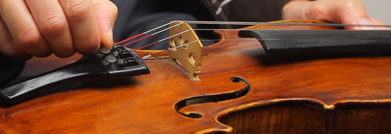
The viola is one of the members of the violin family. They are in many respects similar. They are similar to look in shape, color, listening. They both sound similar, but they are different in many ways.
Note the important differences:
Pitching
Violins normally play upper pitched music while Violas play lower pitched parts. Though both the instruments makes of the same techniques while playing, and the condition of the same level of training and dedication is required to master, but the violin is more basic than the viola.
Size
There is no typical dimension of viola. It is the body is normally is 38cm to 43cm in length. A standard violin has a body that is 35.5cm long. However, viola bows are shorter than the violin bows.
Sound
Among the string family the Violas are the second highest pitched instruments. The typical resonance of the viola is deep and melodious, and slower sound than the violin which has thicker strings. Because of the high pitched sound the instrument is popular melody in the string family.
Tuning and Strings


The strings of the Viola are adjusted to C3, G3, D4 and A4. But, a viola is tuned exactly 1/5 beneath the violin. The viola has a variety of over 3.5 octaves which depends on the aptitude of the player. On the other hand, violin pitched to G3, D4, A4 and E5. However, the top notes are often produced by harmonics, and so the E two octaves over the open E-string (E7) can be considered the practical uppermost note for orchestral parts.
The Playing Style and Technique

The violin is so called When played in a folk manner, but it is called fiddle when played in conventional tones. In reality, the style of playing is the major criterion that differs from the fiddle from the violin. The violinist reproduces the composer’s music with exacting accuracy, down to the loudness of individual notes.
A well-performed violin piece will not deviate in the slightest degree from the composer’s notation of the music. This is also how a symphony can pull off having 50 or more musicians performing in exact unison.
The players must play the instrument following the right postures and gestures. Some untrained or novice play the instruments in a very wrong ways. For example, they do not hold the instrument between the chin and the shoulder, instead they rest it on the their chest. This minimizes the playing output. As most of the time violin support the orchestra or symphony, the learning of this instrument must go in the rightway.